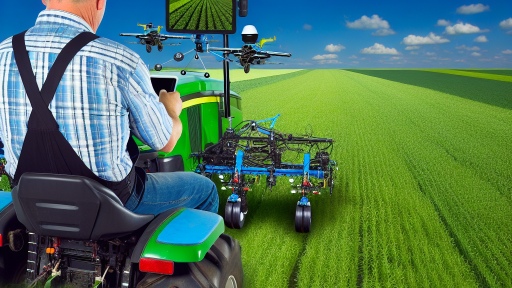Understanding the Importance of Quality Control in Post-Harvest Management
Defining Quality Control
Quality control involves systematic monitoring of processes.
It ensures products meet specific standards and regulations.
This practice helps maintain product consistency and safety.
Impact on Food Quality
Effective quality control enhances the overall quality of food.
It reduces the risk of spoilage and contamination.
This practice ensures that consumers receive safe products.
Economic Benefits
Quality control can lead to significant cost savings.
It minimizes waste and increases the efficiency of operations.
Moreover, consistent quality can enhance brand reputation.
Compliance with Regulations
Adhering to quality control standards supports compliance with regulations.
This practice prevents legal issues and enhances market access.
Furthermore, it fosters consumer trust in products.
Enhanced Market Competitiveness
Companies that implement strong quality control gain a competitive edge.
They can differentiate their products in a crowded market.
Ultimately, this can lead to greater customer loyalty and repeat purchases.
Transform Your Agribusiness
Unlock your farm's potential with expert advice tailored to your needs. Get actionable steps that drive real results.
Get StartedKey Components of Post-Harvest Quality Control Processes
Importance of Post-Harvest Quality Control
Post-harvest quality control ensures food safety and quality.
It helps to prevent food loss during storage and transportation.
Furthermore, effective quality control enhances consumer satisfaction.
Monitoring and Assessment Techniques
Implement regular inspections to evaluate product quality.
Use sensory evaluation methods to assess freshness and taste.
Incorporate technological tools, such as moisture meters, to monitor conditions.
Additionally, employ data analytics for trend analysis over time.
Storage and Handling Practices
Maintain appropriate temperature and humidity levels for stored products.
Utilize proper packing techniques to minimize physical damage.
Train staff on best handling practices to ensure product integrity.
Cleaning and Sanitation Procedures
Establish rigorous cleaning protocols for all equipment and facilities.
Monitor contamination sources to eliminate safety risks.
Implement a regular inspection schedule to ensure cleanliness is maintained.
Traceability and Record Keeping
Develop a traceability system to track products from farm to table.
Maintain accurate records of quality tests and inspections.
This data aids in identifying issues and implementing corrective actions.
Training and Employee Education
Provide ongoing training for employees on quality control standards.
Encourage staff to report quality issues promptly.
Regular workshops reinforce the importance of quality control in operations.
Implementing Standard Operating Procedures in Post-Harvest Steps
Importance of Standard Operating Procedures
Standard Operating Procedures (SOPs) ensure quality consistency during post-harvest processes.
They establish clear guidelines for workers to follow.
Moreover, SOPs help to reduce errors and minimize risks.
Developing Effective SOPs
Creating effective SOPs starts with understanding the processes involved.
Engage experienced workers to share their insights.
Showcase Your Farming Business
Publish your professional farming services profile on our blog for a one-time fee of $200 and reach a dedicated audience of farmers and agribusiness owners.
Publish Your ProfileThis involvement enhances the accuracy and practicality of the SOPs.
Key Components of SOPs
Each SOP should include the following key components:
- Title and purpose of the procedure.
- Step-by-step instructions.
- Safety precautions to protect workers.
- Responsibilities of each team member.
- Verification and validation methods.
Implementation and Training
Once developed, communicate the SOPs clearly to all employees.
Conduct training sessions to ensure everyone understands their role.
Offer practical demonstrations for complex procedures.
Monitoring and Continuous Improvement
Regularly review the SOPs to ensure they remain effective.
Gather feedback from employees about potential improvements.
Adapt the SOPs based on current best practices and new technologies.
Learn More: Temperature Control Strategies for Storage Facilities
Training Staff and Workers in Quality Control Protocols
Importance of Training
Training is essential for maintaining quality control in the post-harvest process.
It ensures all staff understand the standards that need to be met.
Moreover, properly trained employees reduce the risk of quality failures.
Developing a Training Program
A well-structured training program provides comprehensive knowledge.
This program should include the basics of quality control and specific protocols.
In addition, it is crucial to integrate hands-on training for practical experience.
Regular Training Sessions
Conduct regular training sessions to keep everyone updated.
These sessions can address new protocols or revisions in existing procedures.
Regular sessions also reinforce the importance of quality control.
Feedback and Improvement
Implement feedback mechanisms to gauge training effectiveness.
Encourage staff to share their insights on the training process.
Use this feedback to refine and improve the training materials.
Certification and Recognition
Consider offering certifications to employees who complete the training.
This recognition motivates workers to engage actively in quality control.
Additionally, it can enhance the overall competitiveness of your team.
See Related Content: Sustainable Farming Through Advanced Crop Monitoring
Utilizing Technology for Monitoring and Assessment in Post-Harvest Quality
The Role of Technology in Quality Control
Technology plays a crucial role in enhancing post-harvest quality control.
It allows for real-time monitoring of food products.
Adopting digital tools improves accuracy in assessments.
As a result, producers can respond promptly to quality issues.
Sensor Technologies for Real-Time Monitoring
Integrating sensor technologies can revolutionize the monitoring process.
These sensors measure temperature, humidity, and gas emissions.
They provide valuable data about the product’s condition.
Consequently, businesses can maintain optimal storage conditions.
Data Analytics for Informed Decision Making
Data analytics tools enhance decision-making capabilities.
By analyzing historical data, businesses can identify trends.
This information supports strategic adjustments in operations.
Moreover, analytics can predict possible quality issues.
Mobile Applications for On-the-Go Monitoring
Mobile applications have become essential for monitoring quality.
These apps enable easy access to data anywhere, anytime.
Users can quickly record observations and take corrective actions.
Showcase Your Farming Business
Publish your professional farming services profile on our blog for a one-time fee of $200 and reach a dedicated audience of farmers and agribusiness owners.
Publish Your ProfileFurthermore, they facilitate communication among team members.
Automated Systems for Quality Assessment
Automated systems streamline quality assessment processes.
They reduce human error and improve consistency in evaluations.
Also, automation speeds up the assessment timeline.
This efficiency can lead to quicker market delivery for products.
Case Studies of Successful Implementations
Several companies have successfully adopted these technologies.
For instance, FreshTrack uses sensor technology for monitoring fruits.
The system alerts staff about deviations in storage conditions.
Similarly, AgriMonitor has implemented data analytics for grain assessments.
The resultant insights have significantly reduced spoilage rates.
Challenges in Implementing Technology
Despite numerous benefits, technology implementation poses challenges.
Initial costs can be a barrier for small producers.
Moreover, training staff is essential to utilize new systems effectively.
Additionally, integrating various technologies can be complex.
The Future of Technology in Post-Harvest Quality
The future points toward a more integrated use of technologies.
Innovations in artificial intelligence will enhance monitoring capabilities.
These advancements will promote proactive measures in quality control.
As technology evolves, we can expect even greater efficiencies.
Delve into the Subject: Organic Amendments to Enhance Soil Quality

Common Quality Issues in Post-Harvest Handling and Their Solutions
Inadequate Temperature Control
Inadequate temperature control can lead to spoilage of produce.
Fruit and vegetables require specific temperatures for optimal preservation.
A temperature-controlled environment limits the growth of pathogens.
Implementing cold chain logistics is crucial for maintaining quality.
Invest in temperature monitoring devices for real-time data.
Improper Handling Practices
Improper handling practices can cause physical damage to produce.
Bruising reduces the aesthetic appeal and market value of fruits.
Train workers on proper handling techniques to minimize damage.
Using appropriate containers can reduce the risk of injury during transport.
Contamination from Pests and Disease
Pests can introduce pathogens and toxins into the food supply.
Implement a pest management program to combat infestations.
Regularly inspect storage areas to detect signs of contamination.
Use natural repellents and traps to maintain a safe environment.
Poor Packaging Materials
Poor packaging materials can lead to moisture loss and spoilage.
Utilize breathable packaging that maintains humidity levels effectively.
Invest in high-quality materials that provide appropriate protection.
Always consider the product’s specific needs when selecting packaging.
Inconsistent Quality Checks
Inconsistent quality checks can allow inferior products to enter the market.
Establish a robust quality control system to ensure standards are met.
Train staff to perform regular checks at various stages of handling.
Implement a feedback loop for continuous improvement in quality assurance.
Showcase Your Farming Business
Publish your professional farming services profile on our blog for a one-time fee of $200 and reach a dedicated audience of farmers and agribusiness owners.
Publish Your ProfileFind Out More: Harvest Timing Tips to Maximize Yield Quality
Establishing Metrics and KPIs for Measuring Quality Control Success
Importance of Metrics in Quality Control
Metrics provide a clear framework for assessing quality control.
They help identify strengths and weaknesses in processes.
Furthermore, metrics enable tracking of progress over time.
Ultimately, effective metrics lead to informed decision-making.
Key Performance Indicators (KPIs) Defined
KPIs are specific measures that indicate performance levels.
They should align with the overall quality control objectives.
Additionally, KPIs help in comparing performance against benchmarks.
Choosing the right KPIs is crucial for successful evaluation.
Common Metrics to Consider
- Defect Rate: This measures the percentage of defective products.
- Customer Complaints: Tracking complaints indicates potential quality issues.
- Process Yield: This measures the efficiency of production processes.
- Inspection Pass Rate: This refers to the percentage of products passing inspection.
Setting Specific, Measurable Goals
Goals should be specific to focus on key areas for improvement.
Measurable goals allow for tracking and assessment over time.
Additionally, realistic targets ensure motivation and continuous effort.
Examples include reducing defects by a certain percentage.
Implementing Real-Time Monitoring Systems
Real-time monitoring systems facilitate immediate feedback.
They help in quickly identifying issues as they arise.
Moreover, technology can automate data collection for efficiency.
Regular Reviews and Adjustments
Conducting regular reviews ensures the relevance of metrics.
Adjustments can be made based on changing goals or market conditions.
Furthermore, engaging team members in the review process fosters accountability.
Training and Awareness for Team Members
Training enhances understanding of quality control metrics among staff.
Awareness helps in aligning individual performances with company goals.
Additionally, regular workshops can keep the team informed about best practices.
Case Studies: Successful Implementation of Quality Control in Agriculture
Overview of Quality Control in Agriculture
Quality control ensures high standards in agricultural practices.
This process prevents deficiencies in food quality post-harvest.
A well-implemented system enhances overall consumer satisfaction.
Case Study: FreshHarvest Farms
FreshHarvest Farms adopted rigorous quality control measures.
The farm began implementing temperature monitoring in storage facilities.
This initiative reduced spoilage by over 25 percent during storage.
Additionally, they trained staff on proper handling techniques.
The results led to higher customer satisfaction ratings.
Case Study: Green Fields Organic Produce
Green Fields focused on quality inspections at multiple stages.
They introduced a detailed checklist for post-harvest handling.
By doing so, they significantly reduced contamination risks.
Moreover, their strict adherence to organic standards gained market trust.
Consequently, their sales increased by 40 percent within a year.
Case Study: AgroTech Innovations
AgroTech Innovations utilized technology to monitor quality.
They implemented sensors to assess produce freshness in real-time.
This data-driven approach minimized waste effectively.
As a result, the company enhanced its operational efficiency.
Their profits surged as they attracted new clients seeking reliability.
Showcase Your Farming Business
Publish your professional farming services profile on our blog for a one-time fee of $200 and reach a dedicated audience of farmers and agribusiness owners.
Publish Your ProfileKey Takeaways from Successful Implementations
Successful quality control requires comprehensive training for employees.
Effective monitoring and feedback mechanisms are essential.
Embracing technology can lead to significant improvements.
Ultimately, a commitment to quality boosts brand reputation.
These case studies illustrate the benefits of robust quality protocols.




